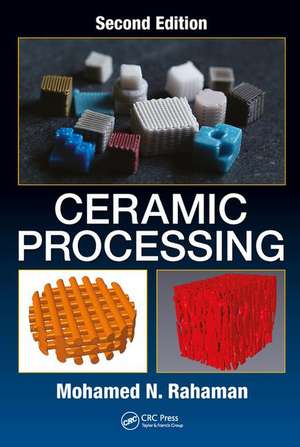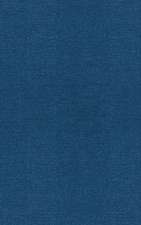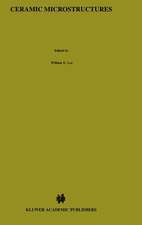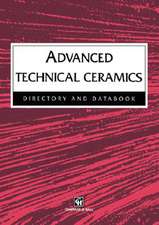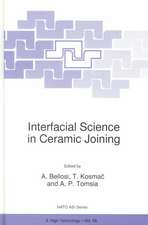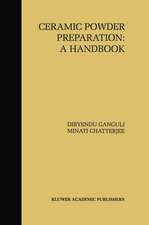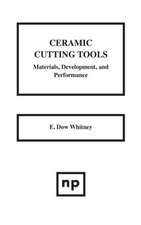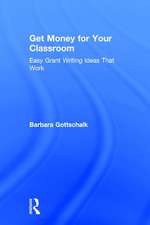Ceramic Processing
Autor Mohamed N. Rahamanen Limba Engleză Hardback – 7 iun 2017
Covering the main steps in the production of ceramics from powders, the book also provides succinct coverage of other methods for fabricating ceramics, such as sol−gel processing, reaction bonding, chemical vapor deposition and polymer pyrolysis.
While maintaining the objectives of the successful first edition, this new edition has been revised and updated to include recent developments and expanded to feature new chapters on additives used in ceramic processing; rheological properties of suspensions, slurries, and pastes; granulation, mixing, and packing of particles; and sintering theory and principles.
Intended as a textbook for undergraduate and graduate courses in ceramic processing, the book also provides an indispensable resource for research and development engineers in industry who are involved in the production of ceramics or who would like to develop a background in the processing of ceramics.
Preț: 776.86 lei
Preț vechi: 1110.22 lei
-30% Nou
Puncte Express: 1165
Preț estimativ în valută:
148.67€ • 154.64$ • 122.74£
148.67€ • 154.64$ • 122.74£
Carte tipărită la comandă
Livrare economică 14-28 aprilie
Preluare comenzi: 021 569.72.76
Specificații
ISBN-13: 9781498716413
ISBN-10: 1498716415
Pagini: 554
Ilustrații: 441 Illustrations, black and white
Dimensiuni: 178 x 254 x 34 mm
Greutate: 1.16 kg
Ediția:2nd edition
Editura: CRC Press
Colecția CRC Press
Locul publicării:Boca Raton, United States
ISBN-10: 1498716415
Pagini: 554
Ilustrații: 441 Illustrations, black and white
Dimensiuni: 178 x 254 x 34 mm
Greutate: 1.16 kg
Ediția:2nd edition
Editura: CRC Press
Colecția CRC Press
Locul publicării:Boca Raton, United States
Cuprins
Chapter One Ceramic Fabrication Processes – An Introductory Overview, Chapter Two Synthesis and Preparation of Powders: Mechanical Methods, Chapter Three Powder Synthesis by Chemical Methods, Chapter Four Synthesis of Ceramic Nanoparticles, Chapter Five Powder Characterization, Chapter Six Science of Colloidal Processing, Chapter Seven Rheology of Colloidal Suspensions, Slurries and Pastes, Chapter Eight Processing Additives, Chapter Nine Granulation, Mixing and Packing of Particles, Chapter Ten Forming of Ceramics; Conventional Methods, Chapter Eleven Additive Manufacturing of Ceramics, Chapter Twelve Drying, Debinding and Microstructural Characterization of Green Articles, Chapter Thirteen Sintering Theory and Fundamentals, Chapter Fourteen Sintering Process Variables and Techniques, Chapter Fifteen Sol−Gel Processing, Chapter Sixteen Ceramic Fabrication Methods for Specific Shapes and Architectures.
Notă biografică
Mohamed N. Rahaman is Professor of Ceramics in the Department of Materials Science and Engineering, University of Missouri–Rolla. He received B.A. (Hons) and M.A. degrees from the University of Cambridge, England, and a Ph.D. degree from the University of Sheffield, England. Prior to joining the University of Missouri in 1986, Dr. Rahaman held positions at the University of Leeds, England; the University of the West Indies, Trinidad; and the Lawrence Berkeley National Laboratory, Berkeley, California. Dr. Rahaman is the author of three books and the author or coauthor of more than 135 publications, most of them in the area of processing and sintering of ceramics.
Recenzii
"The approach is clearly very thorough and seems as if it will be pretty detailed. This book appears to be very thorough in terms of the facts about processes used and how / why they work..."
—Jon Binner, University of Birmingham, United Kingdom
"The book covers a vast amount of information about ceramic processing. The complexity of the field makes it extremely difficult to present in a coherent and educational manner. Rahaman’s book achieves this goal by building on the success of the first edition, with topics being covered in enough depth to provide a comprehensive understanding, while not impounding the massive complexities that can sometimes deviate the reader’s attention and discourage reading. The book catches the readers’ attention by connecting theories with a balanced number of examples, case studies and problems so that concepts are more easily understood and translated to actual processing.
—Ricardo Castro, University of California, Davis, USA
"An excellent book for students and researchers in the field of ceramic processing."
—Jim Song, Brunel University, Uxbridge, London, United Kingdom
"Rahaman’s book is an excellent text book from which to teach/learn the principles of ceramic processing. He develops the underlying science in a systematic manner where the science can be correlated with other related topics in disciplines such as chemistry and physics. The book covers all the main areas of the field and is up to date. I do not want to put any other books down, but this is the only text book which I have found to cover the field of ceramic processing in sufficient systematic breadth and also depth."
—Waltraud M. Kriven, University of Illinois at Urbana-Champaign, USA
"This book is an invaluable addition to the literature on making ceramics. It covers the various steps in manufacture of ceramic components in sufficient depth to be useful to researchers, but in an accessible fashion for teaching undergraduates and graduate students. It will also find a place on the bookshelves of anyone involved with commercial ceramic manufacturers."
—William E Lee, Imperial College London, United Kingdom
"Ceramic processing by Rahaman is an excellent text that introduces undergrad student to the complex and highly varied topic of making ceramics from molecules or powder to the final product. It is furthermore an excellent resource for graduate students and professionals. The chapters are easy to read and understand, yet in depth and high quality. I highly recommend this book to anyone who wants to know more about the field of ceramic processing."
—Wolfgang Sigmund, University of Florida, USA
"Ceramic Processing provides a clear and complete coverage of the fundamental principles and practical aspects of ceramic processing. The book follows a clear logic flow both in its entire structure and local content. It contains conventional techniques as well as modern processes in the field such as sintering of nano-powders, use of additive manufacturing methods, spark plasma sintering and microwave sintering. Very little is missed as far as ceramic processing techniques are concerned. The book can be used as either a text book for students or a good reference for researchers in this field."
—Jingzhe Pan, University of Leicester, United Kingdom
—Jon Binner, University of Birmingham, United Kingdom
"The book covers a vast amount of information about ceramic processing. The complexity of the field makes it extremely difficult to present in a coherent and educational manner. Rahaman’s book achieves this goal by building on the success of the first edition, with topics being covered in enough depth to provide a comprehensive understanding, while not impounding the massive complexities that can sometimes deviate the reader’s attention and discourage reading. The book catches the readers’ attention by connecting theories with a balanced number of examples, case studies and problems so that concepts are more easily understood and translated to actual processing.
—Ricardo Castro, University of California, Davis, USA
"An excellent book for students and researchers in the field of ceramic processing."
—Jim Song, Brunel University, Uxbridge, London, United Kingdom
"Rahaman’s book is an excellent text book from which to teach/learn the principles of ceramic processing. He develops the underlying science in a systematic manner where the science can be correlated with other related topics in disciplines such as chemistry and physics. The book covers all the main areas of the field and is up to date. I do not want to put any other books down, but this is the only text book which I have found to cover the field of ceramic processing in sufficient systematic breadth and also depth."
—Waltraud M. Kriven, University of Illinois at Urbana-Champaign, USA
"This book is an invaluable addition to the literature on making ceramics. It covers the various steps in manufacture of ceramic components in sufficient depth to be useful to researchers, but in an accessible fashion for teaching undergraduates and graduate students. It will also find a place on the bookshelves of anyone involved with commercial ceramic manufacturers."
—William E Lee, Imperial College London, United Kingdom
"Ceramic processing by Rahaman is an excellent text that introduces undergrad student to the complex and highly varied topic of making ceramics from molecules or powder to the final product. It is furthermore an excellent resource for graduate students and professionals. The chapters are easy to read and understand, yet in depth and high quality. I highly recommend this book to anyone who wants to know more about the field of ceramic processing."
—Wolfgang Sigmund, University of Florida, USA
"Ceramic Processing provides a clear and complete coverage of the fundamental principles and practical aspects of ceramic processing. The book follows a clear logic flow both in its entire structure and local content. It contains conventional techniques as well as modern processes in the field such as sintering of nano-powders, use of additive manufacturing methods, spark plasma sintering and microwave sintering. Very little is missed as far as ceramic processing techniques are concerned. The book can be used as either a text book for students or a good reference for researchers in this field."
—Jingzhe Pan, University of Leicester, United Kingdom
Descriere
Ceramic Processing, Second Edition provides a comprehensive treatment of the principles and practical methods used in producing ceramics with controlled microstructure. While maintaining the objectives of the successful first edition, this new edition has been updated and expanded to include several new chapters.
